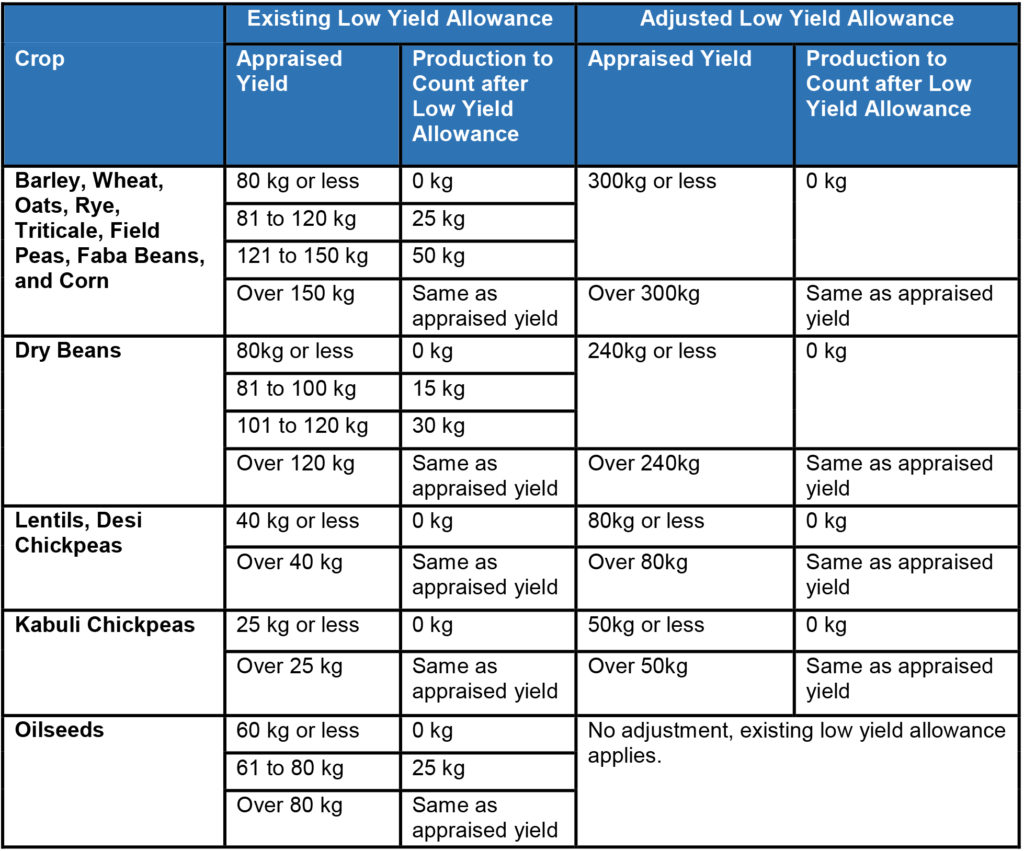Low Yield Allowance Q & As
In response to the extreme heat and dry conditions that contributed to feed shortages during the 2021 crop year, AFSC doubled the Low Yield Allowance (LYA) threshold values for clients who salvaged their cereal or pulse crops as feed.
If the appraised yield falls below the established threshold level, AFSC can reduce the appraisal to zero based on information gathered by the adjuster during the inspection. The appraised yield of the crop is used in the calculation of any subsequent indemnities.
The threshold values are meant to reflect the approximate cost of harvesting when a crop is not worth harvesting.
- This can be applied on a per field basis. It does not have to be applied to the entire crop.
- Low Yield Allowances may be applied to a portion of a field.
- All eligible acres must be put to an alternate use (for feed).
Important to know: The preharvest process remains the same for clients
To help ensure a smoother process, clients should contact AFSC at least five days in advance of starting the work. They will need to provide the crop type, number of acres and estimated yield on the acres that will be put to an alternate use as well as the intended use (e.g. pasturing, silage)
AFSC will work with clients to complete the field inspection as soon as possible. If an adjuster is not able to inspect the field before work is scheduled to start, clients can, once authorized by AFSC, leave standing inspection strips or exclosures on the acres being put to an alternate use. AFSC will complete the inspection and determine a yield appraisal as soon as possible.
Low Yield Allowance Q&A
Changes have been made to Low Yield Allowance for crops taken out of production for livestock feed. Examples are silaging, baling and pasturing.
Please note: Current thresholds will be applied to crops that are abandoned or harvested, while the adjusted thresholds will be applied to crops that are put up for feed.
Q: My crop has already been inspected by AFSC and I’ve begun hay/silaging the crop. With the announcement of an increase in the Low Yield Allowance threshold, do I need to do anything else?
No, you don’t have to do anything further. AFSC will track all previously appraised yield potentials. If the yield appraisal assessed on your acres now falls into the new low yield allowance, you will receive the same treatment/compensation regardless of when the claim was inspected.
Q: Why is the Low Yield Allowance adjustment only applied to poor crops put to feed?
AFSC is changing the threshold values for the Low Yield Allowance to help encourage farmers to salvage poor crops for feed, rather than abandoning the acres.
Q: Will this Low Yield Allowance apply if I opt to combine my crop?
The Low Yield Allowance applies to all harvested crops, based on the average of the whole crop, rather than on a spot-loss basis. Combined crops will continue to have the established low yield allowances apply.
The recent threshold adjustment only applies to crops put to another use as livestock feed.
Q: My crop is damaged to the point where there is nothing to salvage for feed. Does this adjustment impact me?
If the crop is worth less than the cost of harvesting it and you intend to abandon it, the adjustment will not apply. Your crop may fall into the standard low yield appraisal and count as zero yield.
Q: Why isn’t canola included in the changes to the low yield allowance?
As an oilseed, canola isn’t typically a crop put to another use for feed, although it may be in extreme circumstances. The existing Low Yield Allowance remains place for all oilseed crops and clients will be compensated for their losses when the total insured acres of the canola crop fall below coverage levels.
Q: Is this change for the 2021 crop year only?
This change is for the 2021 crop year only.
If you have additional questions or need assistance, please use Live Chat on our website or AFSC Connect, call our Client Service Centre at 1-877-899-2372 or contact your branch office.

